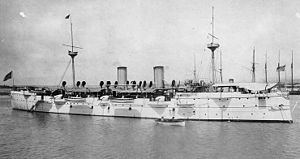Start date October 1891 | ||
 | ||
Similar Chilean Civil War of 1891, Itata incident, Battle of Caldera Bay, Battle of Concón, Battle of Placilla | ||
The Baltimore crisis was a diplomatic incident that took place between Chile and the United States, after the 1891 Chilean Civil War, as result of the growing American influence in Pacific Coast region of Latin America in the 1890s. It marked a dramatic shift in United States–Chile relations. It was triggered by the stabbing of two United States Navy sailors from the USS Baltimore in front of the "True Blue Saloon" in Valparaíso on October 16, 1891. The United States government demanded an apology. Chile ended the episode when it apologized and paid a $75,000 indemnity.
Contents
Baltimore crisis in usa part 1
Background
In 1884 Chile emerged from the War of the Pacific as a potential threat to the hegemony of the United States. The Chilean navy, then the strongest fleet in the Pacific, was able to confront American policy. In 1882 Chile refused US mediation in the War of the Pacific. During the Panama crisis of 1885, as the United States Navy occupied Colón, then part of Colombia, the Chilean government ordered its navy to occupy Panama City and not to leave until after the American forces evacuated Colon. Finally in 1888 Chile annexed Easter Island, located some 2,000 miles west of Valparaíso, and by occupying Easter Island, Chile joined the imperial nations.
But by 1891 the equation of power had changed. The United States possessed more naval power and, more significantly, Alfred Thayer Mahan's theories were needed to secure the growing influence of the United States in Latin America.
During the Chilean Civil War the American government supported the forces of President Jose Manuel Balmaceda and enforced a ban on exports for the insurgents that was supported partially by the United Kingdom. These and another circumstances troubled relations between the United States and the victorious former insurgents, who in 1891 defeated the presidential forces and were then in power in Chile.
Just before the end of the Chilean Civil War the United States sent a group of ships including the USS Charleston to force the Chilean insurgents' cargo ship Itata, that illegally loaded arms in San Diego for the insurgents, to return to San Diego. The US ships reached Iquique before the Itata. The new Chilean government ordered the ship back to San Diego to face outstanding charges.
During the war the American owned Central and South American Cable Company, by order of the Balmaceda administration, restored submarine telegraph cable service between Santiago and Lima and sundered the cable connection to the insurgent headquarters.
In addition, the United States minister in Santiago gave diplomatic asylum to various insurgent leaders during the war and to Balmaceda's supporters after the war. The victorious insurgents called upon the American minister in Santiago, Patrick Egan, to surrender the newest refugees to the authorities but it was refused.
From the insurgents' point of view, the United States had tried to stop them from purchasing weapons, denied the rebels access to international telegraph traffic, spied on the insurgent troops, and refused to surrender war criminals.
USS Baltimore incident
On October 16, 1891, a mob attacked a group of sailors on shore leave from the cruiser USS Baltimore outside a bar in the Chilean port of Valparaíso after one of the American sailors spit on a picture of Arturo Prat (Chilean national hero). Two sailors were killed and seventeen to eighteen were injured.
The new Chilean government initially rejected American protests. However, after United States President Benjamin Harrison sent a strong message to the United States Congress, Chile apologized and paid $75,000 in gold.
